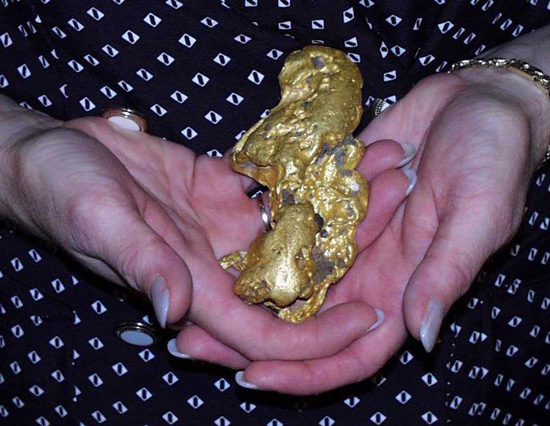Gold
Prospecting
We
gradually started this hobby in about the year 2001 after a visit to the
Natural History museum in London. The kids have always been interested in
rocks and minerals. During our visit we saw the gold cabinet and our interest
grew from there. We have been to many places in Scotland and Wales. First it
was taking long walks to old gold mines and scraping away on the tips. Mostly
we were finding fools gold, but it was a great learning experience in looking
at all the different rocks etc.
It also is a great opportunity to be out in the fresh air, away from built up areas, and above all, it is free to do.


Here
is our first sample of gold that we found. We went to Scotland prospecting on
the Menock, then the Kildonan. Then to Wales at half term. As we gained more
experience, we are now finding about the same amount every trip.
You will hear
people talking about their gold in terms like flakes and flour. Some people
will tell you that a nugget they found weighs a pennyweight. When you are new
at this, these terms sound real foreign. So, just what do all these things
mean?
WHAT TO
CALL THAT GOLD YOU FOUND.
FLOUR-----This
should be obvious. The gold you found looks like baking flour, only it is
gold. Sometimes it is even microscopic in size, and people wonder how you
found it without a magnifying glass.
SPECK-----This
is going to be just a bit bigger than FLOUR, but it is still very small.
FLECK-----This
is similar to a SPECK, but it is flatter in shape, and still very small.
FLAKE-----Now
we're getting somewhere! A FLAKE is going to be larger in size. You will begin
to get excited when the gold you are finding reaches FLAKE size. A FLAKE is
still too small to pick up with your finger, but you can get it with a
tweezers.
PICKER-----Yahoo!
This is a piece of gold big enough to pick up with your finger and thumb. If
you have to fumble around to get it, it is a SMALL PICKER. If you can pick it
out rather easily, it qualifies as a NICE PICKER. If it is real easy to pick
up, it is probably a BIG PICKER.
When you
actually hear a piece of gold hitting the bottom of your pan, or the bottom of
your sluice, you may get real excited. Some people call these PLINKERS, but
for the most part, they are SMALL NUGGETS. If one dents your pan or sluice, no
doubt about it, you got a NUGGET!

Some of the basic tools for panning! Obviously you need a pan. A half-inch sieve is useful for removing the larger stones, Be careful you don't lose them large nuggets though! A Henderson pump, for sucking up gravels from around large rocks. Have a look at a nugget or two that you might find in your sieve. (I wish!) This is a 32.3 oz nugget. No, this is not Alison holding it... She would never wear that sort of dress!

Here are the experts hard at it in Wales during the autumn of 2003.

We
were privileged to have this professional photo taken of us while panning.

One
of the many places where we have found quite a lot of gold.


Sometimes we
get out our sluice. This speeds up the process, the water rushing through,
washes away the unwanted gravels leaving the heavier materials behind. On the
right you can see the sluice situated on a small weir, it is important that
the water flows down the sluice so that it carries away the lighter unwanted
gravel, leaving behind the gold.... Bullion!
Here is an
interesting site: -
Photos of excellent Gold samples from around the world.